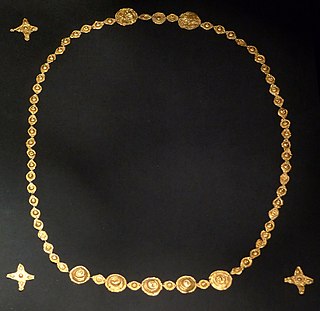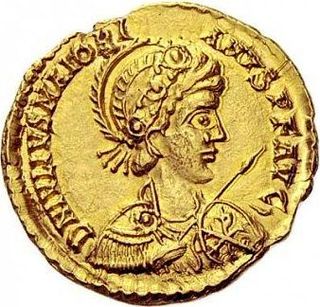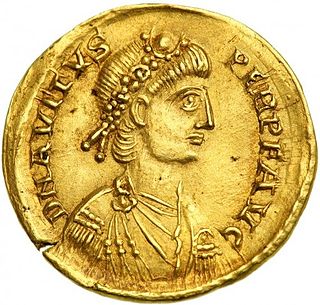The 450s decade ran from January 1, 450, to December 31, 459.
The 460s decade ran from January 1, 460, to December 31, 469.

Year 456 (CDLVI) was a leap year starting on Sunday of the Julian calendar. At the time, it was known as the Year of the Consulship of Avitus without colleague. The denomination 456 for this year has been used since the early medieval period, when the Anno Domini calendar era became the prevalent method in Europe for naming years.

The Vandals were a Germanic people who first inhabited what is now southern Poland. They established Vandal kingdoms on the Iberian Peninsula, Mediterranean islands, and North Africa in the fifth century.

Ricimer was a Romanized Germanic general, who ruled the remaining territory of the Western Roman Empire from 456 after defeating Avitus, until his death in 472, with a brief interlude in which he contested power with Procopius Anthemius. Deriving his power from his position as magister militum of the Western Empire, Ricimer exercised political control through a series of puppet emperors. Ricimer's death led to unrest across Italy and the establishment of a Germanic kingdom on the Italian Peninsula.

Majorian was the Western Roman emperor from 457 to 461.

Procopius Anthemius was the Western Roman emperor from 467 to 472. Born in the Eastern Roman Empire, Anthemius quickly worked his way up the ranks. He married into the Theodosian dynasty through Marcia Euphemia, daughter of Eastern emperor Marcian. He soon received a significant number of promotions to various posts, and was presumed to be Marcian's planned successor. However, Marcian's sudden death in 457, together with that of Western emperor Avitus, left the imperial succession in the hands of Aspar, who instead appointed Leo, a low-ranking officer, to the Eastern throne, probably out of fear that Anthemius would be too independent. Eventually, this same Leo designated Anthemius as Western emperor in 467, following a two-year interregnum that started in November 465.

Eparchius Avitus was Roman emperor of the Western Empire from July 455 to October 456. He was a senator of Gallic extraction and a high-ranking officer both in the civil and military administration, as well as Bishop of Piacenza.
Placidia was a daughter of Valentinian III, Roman emperor of the West from 425 to 455, and from 454/455 the wife of Olybrius, who became western Roman emperor in 472. She was one of the last imperial spouses in the Roman west, during the Fall of the Western Roman Empire during Late Antiquity.

The Battle of Cartagena occurred on May 13, 460 or 461 and was part of the wars of Majorian. Although many sources call it battle of Cartagena, the battle did not take place at Cartagena but on the coast of Roman Carthaginensis province at Portus Ilicitanus in the bay of Alicante. Since Portus Ilicitanus was the port of Elche (Ilici), the battle is sometimes referred as battle of Elche.
460: Eo anno captae sunt naves a Vandalis ad Elecem juxta Carthaginem Spartariam.

Marcellinus was a Roman general and patrician who ruled over the region of Dalmatia in the Western Roman Empire and held sway with the army there from 454 until his death. Governing Dalmatia both independently from, and under, six Emperors during the twilight of the Western Empire, Marcellinus proved to be an able administrator and military personality with sources making reference that he ruled justly and well and kept Dalmatia independent of the emperor and of barbarian rulers.

Libius Severus, sometimes enumerated as Severus III, was Western Roman emperor from November 19, 461 to his death on November 14, 465. A native of Lucania, Severus was the fourth of the so-called "Shadow Emperors" who followed the deposition of the Valentinianic dynasty in 455. He ruled for just under four years, attaining the throne after his predecessor, Majorian, was overthrown by his magister militum, Ricimer. Severus was the first of a series of emperors who were highly dependent on the general, and it is often presumed that Ricimer held most of the de facto power during Severus' reign
Gaiseric, also known as Geiseric or Genseric was king of the Vandals and Alans from 428 to 477. He ruled over a kingdom and played a key role in the decline of the Western Roman Empire during the 5th century.

The Battle of Cape Bon was an engagement during a joint military expedition of the Western and Eastern Roman Empires led by Basiliscus against the Vandal capital of Carthage in 468. The invasion of the kingdom of the Vandals was one of the largest amphibious operations in antiquity, with 1,113 ships and over 50,000 personnel.

The Vandal Kingdom or Kingdom of the Vandals and Alans was a confederation of Vandals and Alans, which was a barbarian kingdom established under Gaiseric, a Vandalic warlord. It ruled parts of North Africa and the Mediterranean for 99 years from 435 to 534 AD.
The Battle of Corsica was fought between the Vandals and the Western Roman Empire in Corsica in 456. Prior to the battle, the Vandals had captured Carthage and made it the capital of their kingdom. In 456, a Vandal fleet of 60 ships sailed from Carthage, threatening both Gaul and Italy. The Vandals were defeated at Agrigentum by the comes militaris per Italia, the Suebian warrior, Ricimer, who was acting for Emperor Avitus, after which they sailed for Corsica. At Corsica the Vandals were again attacked by Ricimer and defeated. After having defeated the Vandals, Ricimer returned to Italy as a hero. However, he soon defected from Avitus and defeated him at Placentia.

The Roman Civil War of 456 was a civil war fought in the Western Roman Empire during the second half of 456 AD.

The Vandal War (461–468) was a long-term conflict between the two halves of the Roman Empire on the one hand and the Vandals in North Africa on the other. This war revolved around hegemony in the Mediterranean and the empire of the west. The Vandals as a rising power posed an enormous threat to the stability of the Roman Empire. Piracy and plunder were a scourge, threatening trade throughout the Mediterranean. The Roman war effort from 466 onwards was aimed at the destruction of the Vandal Kingdom in order to restore the empire to its original territory. Armed conflicts alternated with peace talks and the two parts of the Roman Empire did not always act in unison.












